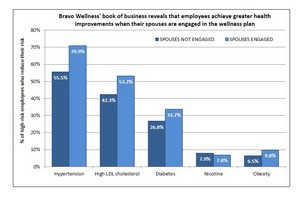CLEVELAND, OH--(Marketwired - Jun 21, 2013) - Measuring the effectiveness of corporate wellness programs has become a daunting task. Do you calculate the total number of pounds lost? Do you evaluate the number of individuals that lowered their blood pressure? Do you base your success on the number of participants and the feedback they provide? Do you approach it in terms of reduced sick days? Or perhaps the best method is through an analysis of claims cost? Can the value of wellness programs truly be measured? Bravo Wellness believes it can, and has seen first-hand how implementing outcomes-based incentive programs has changed the way their clients benefit from corporate wellness programs.
Outcomes-based wellness incentive programs can be described as any method in which a reward or penalty is tied to an individual achieving or making progress toward a standard related to a predetermined health status factor or an improvement goal. When employers design an outcomes-based incentive program as part of their overall wellness strategy, multiple regulatory and HIPAA requirements must be met in order to keep the program fair, legal and compliant. Bravo Wellness administers outcomes-based, improvement-based and participation-based (activity) wellness programs. Although there are advantages to each approach, Bravo's recommended strategy to ease from activities into results is growing evidence of its efficacy.
Graco, Inc. is a leader in the management of fluids and coatings in both industrial and commercial applications. Committed to helping its employees get the most from its health and wellness plan, Graco is also dedicated to controlling health care costs. What started as a participation-based program with employees earning premium reduction incentives for completing various health activities has become an outcomes-based program that drives accountability and real behavior change. Since implementing the outcomes-based program administered by Bravo, Graco employees have seen significant improvements in five of six graded health criteria -- including an 80% reduction in high blood pressure readings and more than 50% reduction in high LDL cholesterol readings. Additionally, Graco has seen a 3.9% decrease in obesity among participants despite the rising national obesity trend. As a result, these healthier employees are slowing the trend of rising medical and pharmaceutical costs for Graco; only a 2.3% annual growth rate for those within the program vs. a 7.4% annual rate for non-participants. Considering the difference this program made with employees, Graco has decided to incorporate spouses into the next plan year.
Spouse engagement in wellness can be a critical part of the overall success of an employee benefits strategy. An analysis of Bravo Wellness' book of business confirms that employee health noticeably improves when spouses have the same opportunities to engage in the wellness programs that the employees do. The analysis shows the percentage of employees who moved from high risk to moderate or even low risk within one year of their health screening with Bravo. (See accompanying chart.)
According to the Health Management Research Center at the University of Michigan, reducing one or two risk factors with employees or spouses can mean a substantial savings of $3,000 per risk factor for the employer. This means even small health improvements or progress can have a large impact.
In addition to Graco's success, another Bravo Wellness client also saw a dramatic drop in claims costs. As a community-based hospital recognized for the quality of medical care, Southwest General Health Center has a long history of offering a comprehensive and competitive health and wellness plan to its employees. Upon realizing though that their offerings were seeing low participation and not meeting company goals, they slowly integrated their program. After only one year of applying the outcomes-based model, Southwest General's claims trend decreased from 16% per year to 1% and it has held steady since then. Read the full case study at http://www.bravowell.com/history/case-studies.
These astonishing results are not uncommon for Bravo Wellness clients. Bravo's clients average 97% participation when one of their typical outcomes-based plans is implemented. Bravo has also mastered the art of creating "cost neutral" plan designs where the employees who don't achieve all of the goals or complete their alternative means to qualify (typically an easier to achieved improvement goal, determined by their personal physician) pay just enough more in their contributions to completely fund the entire wellness program. Bravo's clients are seeing the evidence that outcomes-based incentive programs are not only effective in terms of improving employee and covered spouse's health, but they are seeing a direct impact to their bottom line.
About Bravo Wellness - Bravo Wellness is the thought leader in wellness incentive programs. Bravo's market leadership provides unique insights into industry best practices, identifies ways to mitigate the cost of healthcare, and minimize potential legal risks or concerns. Through our best practices, Bravo helps employers engage their employees, foster personal accountability, and bring about real behavior change towards health and wellness. Bravo Wellness and its subsidiary, IncentiSoft Solutions, are headquartered in Cleveland, OH. For more information, visit www.bravowell.com.
Contact Information:
For more information, please contact
Corporate Marketing
877.662.7286
Bravo Wellness
One International Place
20445 Emerald Parkway Dr. SW
Suite 400
Cleveland, OH 44135
